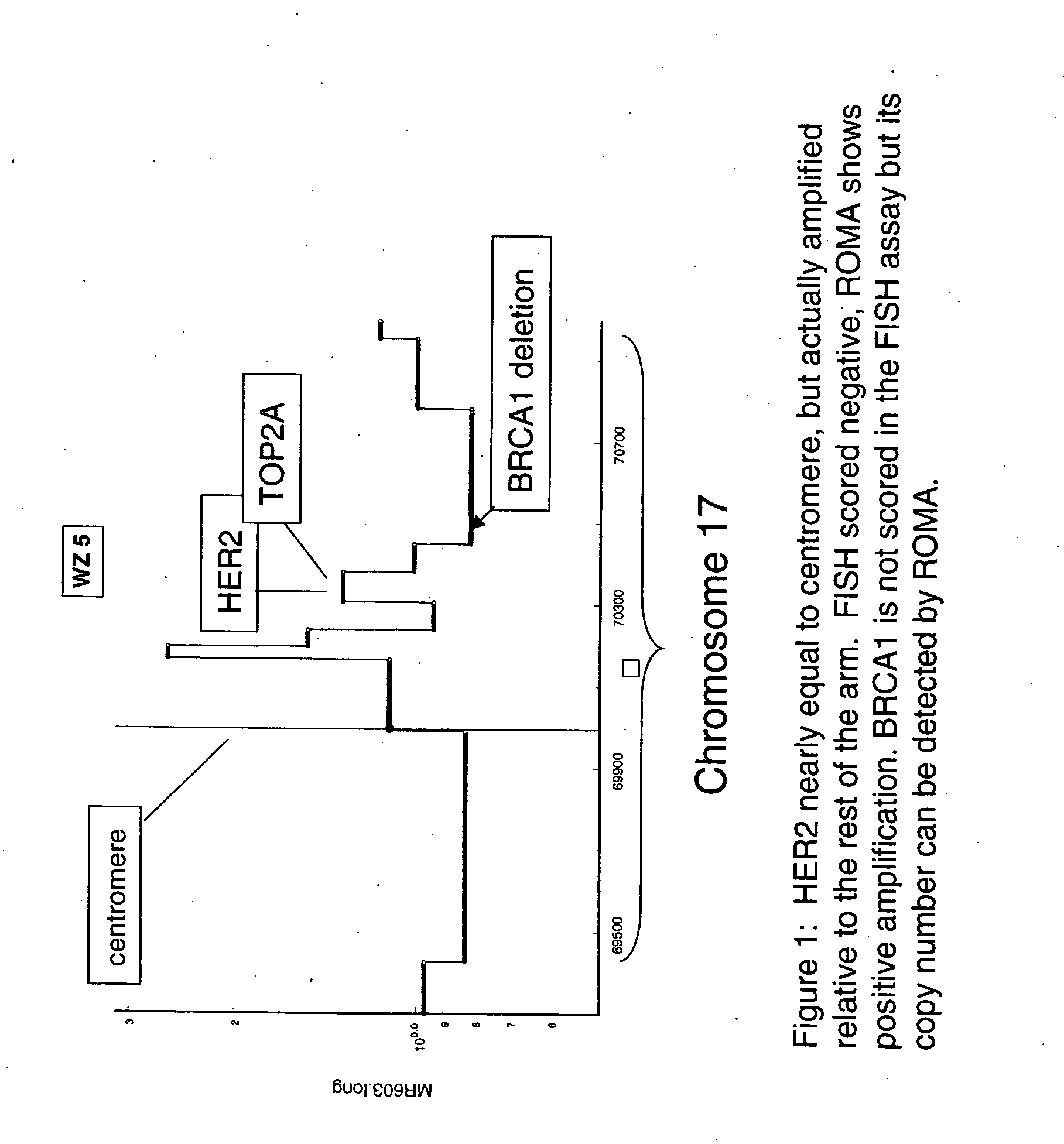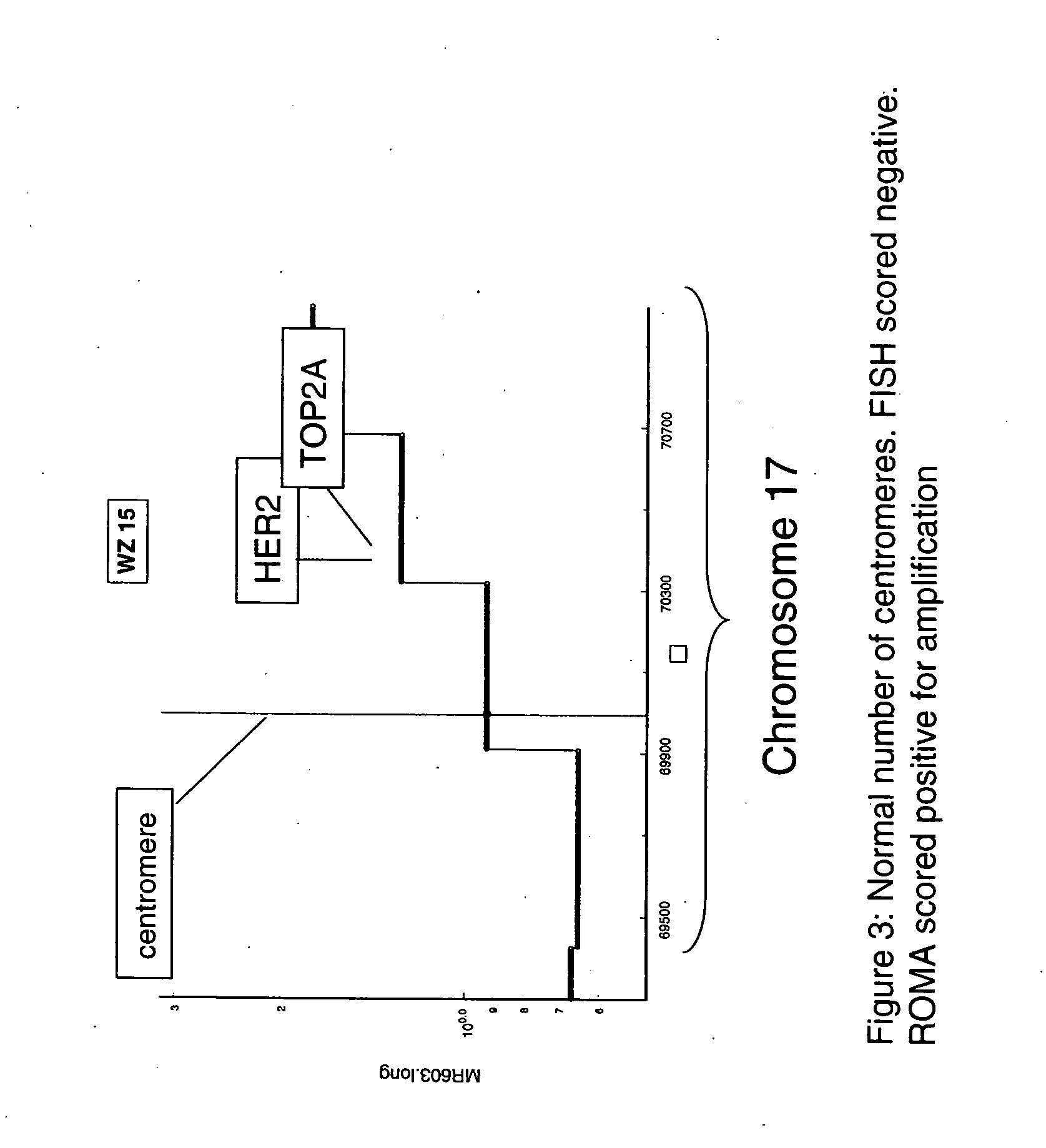Use of roma for characterizing genomic rearrangements
a genomic rearrangement and roma technology, applied in the field of roma for characterizing genomic rearrangements, can solve the problems of insufficient predictors of treatment efficacy of other diseases and disorders, use of histopathological and clinical criteria, and significant and unmet need for accurate diagnostic methods to improve patient car
- Summary
- Abstract
- Description
- Claims
- Application Information
AI Technical Summary
Benefits of technology
Problems solved by technology
Method used
Image
Examples
example 1
Materials and Methods
[0101] Formalin-fixed, paraffin-embedded (FFPE) tissue samples were obtained from the Pathology Department of Memorial Sloan-Kettering Cancer Center (MSKCC). The samples consist of unmounted 15 micron microtome slices taken from recently archived tumor tissue blocks. In most cases DNA was prepared between three and six months of original processing of the tissue for clinical histopathology. In all cases, samples were selected, prepared and coded at MSKCC before being sent to CSHL for ROMA analysis. Samples were given a score for amplification based on ROMA results and those scores were compared to the original pathology laboratory results at MSKCC. No additional patient identification or other clinical information was transferred to CSHL in this study.
[0102] ROMA and IHC / FISH results were compared between two different sample sets. The first set (Set A) was made up of 25 samples selected to contain a larger proportion of IHC+ / FISH+ cases than would be present ...
example 2
Probe Design for FISH
[0104] Hybridization probes for FISH were constructed in one of two methods. For the interdigitation analysis, probes were created from bacterial artificial chromosomes (BAC) selected using the UCSD Genome Browser. For the determination of copy number in the deletions and amplifications of the aneuploid tumors, probes were made with PCR amplification of primers identified through the PROBER algorithm designed in this laboratory (Navin et al. 2006). Genomic sequences of 100 kb containing target amplifications were tiled with 50 probes (800-1400 bp).
[0105] Oligonucleotide primers were ordered in 96-well plates from Sigma Genosys and resuspended to 25 μM. Probes were amplified with the PCR Mastermix kit from Eppendorf (Cat. 0,032,002.447) from EBV immortalized cell line DNA (Chp-Skn-1) DNA (100 ng) with 55° C. annealing, 72° C. extension, 2 min extension time, and 23 cycles. Probes were purified with Qiagen PCR purification columns (Cat. 28,104) and combined into...
example 3
Correlation of FISH and ROMA in Selected Cases (SET A)
[0108] The data presented in Table 1 show a remarkably good agreement between FISH and ROMA data. The data for the predominantly Her-2+ cases in Set A in Table 1 show that all cases that scored negative by FISH were scored negative by ROMA (4 / 4). For the cases scored positive by FISH, all but one were detected by ROMA (20 / 21). Furthermore, with one exception (BTL19) the estimates for degree of amplification by the two techniques show a strong correlation. The single case that was scored as a false negative by ROMA (BTL16) had only 20% tumor cells and thus sets an apparent lower limit on the ratio of tumor / normal nuclei in the sample tissue for efficient detection by a mass technique such as ROMA.
PUM
| Property | Measurement | Unit |
|---|---|---|
| fluorescence in situ hybridization | aaaaa | aaaaa |
| compositions | aaaaa | aaaaa |
| size | aaaaa | aaaaa |
Abstract
Description
Claims
Application Information
 Login to View More
Login to View More - R&D
- Intellectual Property
- Life Sciences
- Materials
- Tech Scout
- Unparalleled Data Quality
- Higher Quality Content
- 60% Fewer Hallucinations
Browse by: Latest US Patents, China's latest patents, Technical Efficacy Thesaurus, Application Domain, Technology Topic, Popular Technical Reports.
© 2025 PatSnap. All rights reserved.Legal|Privacy policy|Modern Slavery Act Transparency Statement|Sitemap|About US| Contact US: help@patsnap.com



